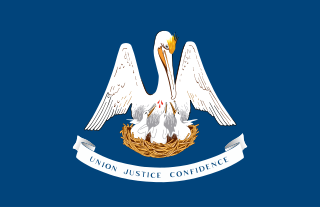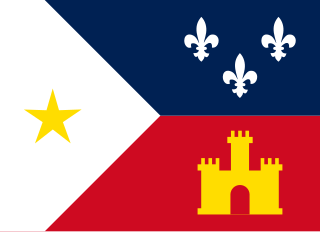
The national flag of France is a tricolour featuring three vertical bands coloured blue, white, and red. It is known to English speakers as the Tricolour, although the flag of Ireland and others are also so known. The design was adopted after the French Revolution, where the revolutionaries were influenced by the horizontally striped red-white-blue flag of the Netherlands. While not the first tricolour, it became one of the most influential flags in history. The tricolour scheme was later adopted by many other nations in Europe and elsewhere, and, according to the Encyclopædia Britannica has historically stood "in symbolic opposition to the autocratic and clericalist royal standards of the past".

The fleur-de-lis, also spelled fleur-de-lys, is a lily that is used as a decorative design or symbol.

The National Flag of Canada, often simply referred to as the Canadian flag or, unofficially, as the maple leaf flag or l'Unifolié, consists of a red field with a white square at its centre in the ratio of 1∶2∶1, in which is featured a stylized, red, 11-pointed maple leaf charged in the centre. It is the first flag to have been adopted by both houses of Parliament and officially proclaimed by the Canadian monarch as the country's official national flag. The flag has become the predominant and most recognizable national symbol of Canada.

The flag of Quebec, called the Fleurdelisé, represents the Canadian province of Quebec. It consists of a white cross on a blue background, with four white fleurs-de-lis.

The flag of Louisiana consists of a rectangular field of blue with the arms of Louisiana, the pelican vulning herself, in white in the center, with a ribbon beneath, also in white, containing in blue the state motto: "Union Justice Confidence." The flag was officially adopted July 1, 1912, and is often referred to as the Pelican flag.

The Illinois Country —sometimes referred to as Upper Louisiana —was a vast region of New France claimed in the 1600s in what is now the Midwestern United States. While those names generally referred to the entire Upper Mississippi River watershed, French colonial settlement was concentrated along the Mississippi and Illinois Rivers in what is now the U.S. states of Illinois and Missouri, with outposts on the Wabash River in Indiana. Explored in 1673 from Green Bay to the Arkansas River by the Canadien expedition of Louis Jolliet and Jacques Marquette, the area was claimed by France. It was settled primarily from the Pays d'en Haut in the context of the fur trade, and in the establishment of missions by French Catholic religious orders. Over time, the fur trade took some French to the far reaches of the Rocky Mountains, especially along the branches of the broad Missouri River valley. The French name, Pays des Ilinois, means "Land of the Illinois [plural]" and is a reference to the Illinois Confederation, a group of related Algonquian native peoples.

The city of Kraków uses a coat of arms, a seal, official colors, a flag, and a banner as its official symbols. Additionally, a number of semi-official and unofficial symbols of the city are also used.

Louisiana or French Louisiana was an administrative district of New France. Under French control from 1682 to 1762 and 1801 (nominally) to 1803, the area was named in honor of King Louis XIV, by French explorer René-Robert Cavelier, Sieur de la Salle. It originally covered an expansive territory that included most of the drainage basin of the Mississippi River and stretched from the Great Lakes to the Gulf of Mexico and from the Appalachian Mountains to the Rocky Mountains.

The flag of St. Louis, Missouri, consists of a solid red background and three thick, wavy lines colored blue and white extending from the top left corner, bottom left corner, and center right edge. At the intersection of these lines there is a yellow disk containing a blue fleur-de-lis.
The people and province of Quebec have created and established several symbols throughout Quebec's history to represent the collective identity of its residents. Many of Quebec's symbols are related to its history, to catholicism, to Quebec's winters and/or the fauna and flora of Quebec. The motif most commonly seen in Quebec's various symbols is the fleur de lys, which is associated with the French language and New France.

The flag of Baton Rouge is the city flag of Baton Rouge, capital city of Louisiana. It has a red field with a small shield and cursive text reading "Baton Rouge". The current flag was adopted in 1995 by the city council, replacing an older flag that had been in use since 1968.

The flag of Saint Barthélemy is the French tricolor. This is because Saint Barthélemy is a self-governing overseas collectivity of France. An unofficial flag of Saint Barthélemy consisting of the island's coat of arms centered on a white field is also used on the island.
The Decoration of the Lily was a French medal created by the Bourbon Restoration in 1814.

French heraldry is the use of heraldic symbols in France. Although it had a considerable history, existing from the 12th century, such formality has largely died out in France, as far as regulated personal heraldry is concerned. Civic heraldry on the other hand remains a visible part of daily life.

The flag of Acadiana represents the Acadian (Cajun) ethnic region of southern Louisiana. It consists of two equal horizontal bands of blue (top) and red (bottom) bearing three white fleurs de lis and a gold castle, respectively, and a white isosceles triangle at the hoist, within which is a gold five-pointed star. It was designed in 1965 and officially adopted July 5, 1974. The flag is referred to as the Acadiana flag or Cajun flag.

National symbols of France are emblems of the French Republic and French people, and they are the cornerstone of the nation's republican tradition.

The current flag of Montgomery County, Maryland, was adopted on October 5, 1976. It was designed by the British College of Arms. It is commonly flown outside of the Montgomery County's governmental facilities, such as fire stations.

The flag of Fort Wayne, Indiana, was adopted as the city's official flag by City Council on June 26, 1934. The pall design includes two diagonal white stripes converging in the circular center to form a horizontal white stripe. Red silhouettes of a Miami Native American head, a French fleur-de-lis, and a British lion grace a navy blue field. A red blockhouse is located at the center of the converging stripes, with the settlement's founding date and city name.













